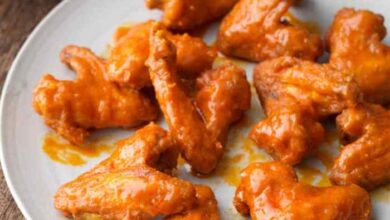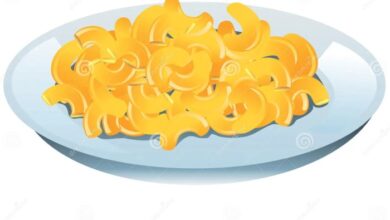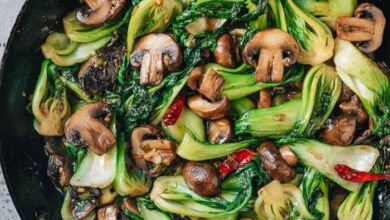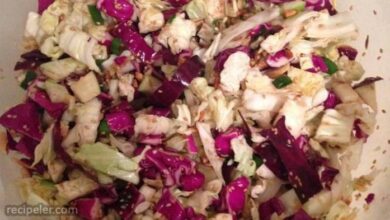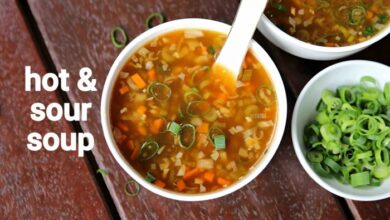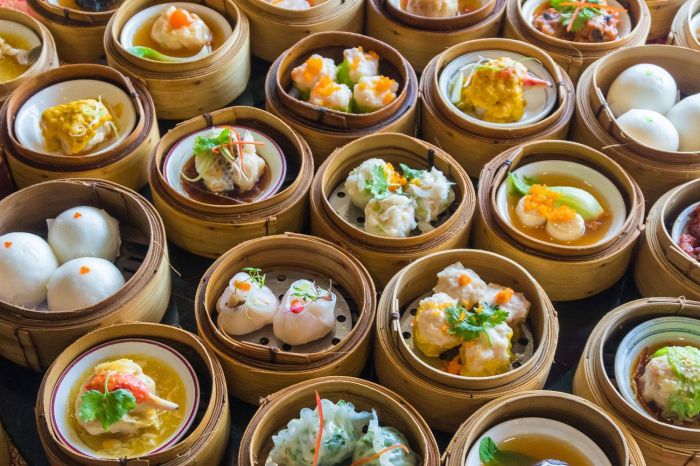
Dim Sum Asian Dumplings: A Culinary Journey
Dim Sum Asian Dumplings, a culinary adventure that transcends mere food and becomes an experience, a celebration of flavors, textures, and traditions. From the bustling streets of Hong Kong to the modern-day dim sum houses around the world, these bite-sized parcels of joy have captivated palates and hearts for centuries.
The history of dim sum is intertwined with the evolution of Chinese culture, its origins tracing back to the teahouses of Southern China. These delicate morsels, once served as a light snack alongside tea, have transformed into a full-fledged culinary art form, a symphony of tastes and textures that embodies the essence of Chinese cuisine.
The History of Dim Sum
Dim sum, a beloved culinary tradition in Chinese culture, is more than just a meal; it’s a social experience deeply rooted in history and tradition. This article delves into the fascinating origins of dim sum, tracing its evolution from humble beginnings to its diverse modern-day variations.
The Origins of Dim Sum
Dim sum, meaning “to touch the heart,” originated in southern China during the Qing dynasty (1644-1912). Its roots can be traced back to teahouses, where weary travelers and merchants would stop for a quick bite and a cup of tea.
These teahouses offered small, bite-sized snacks called “點心” (dim sum) served alongside tea. The concept of dim sum was influenced by the nomadic lifestyle of the Han Chinese, who carried small portions of food for sustenance during long journeys.
The Evolution of Dim Sum
Dim sum evolved over time, becoming more elaborate and diverse. The availability of new ingredients and cooking techniques led to the creation of a vast array of dim sum dishes, each with its own unique flavor and history.
- Early Dim Sum:Early dim sum consisted of simple, savory snacks like steamed buns, dumplings, and rice rolls. These dishes were often made with readily available ingredients like rice flour, pork, and vegetables.
- The Rise of Dim Sum Restaurants:As dim sum gained popularity, specialized restaurants began to emerge, offering a wider variety of dishes and a more refined dining experience.
- Modern Dim Sum:Today, dim sum is a highly diverse culinary tradition, encompassing hundreds of dishes, from classic favorites to innovative creations. Regional variations have emerged, with each region developing its own signature dim sum dishes.
Dim Sum in Chinese Social Gatherings
Dim sum holds a special place in Chinese social gatherings and celebrations. The tradition of sharing dim sum dishes fosters a sense of community and strengthens social bonds.
- Family Gatherings:Dim sum is a popular choice for family gatherings, providing an opportunity for loved ones to come together and enjoy a leisurely meal.
- Business Meetings:Dim sum is also a common choice for business meetings, as the relaxed atmosphere and shared plates facilitate conversation and networking.
- Festival Celebrations:Dim sum is often served during Chinese festivals, such as the Lunar New Year and Mid-Autumn Festival, symbolizing good fortune and prosperity.
Dim Sum and Asian Culture
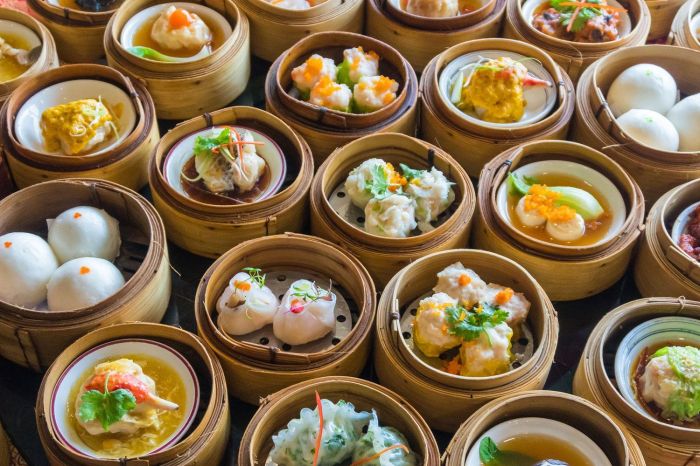
Dim sum, a beloved tradition in many Asian cultures, is more than just a meal; it’s a social experience, a celebration of community, and a reflection of rich culinary history. From its humble beginnings in southern China, dim sum has evolved into a global phenomenon, captivating palates worldwide with its diverse flavors and vibrant presentation.
Dim Sum’s Role in Chinese Cuisine
Dim sum holds a special place in Chinese cuisine, particularly in Cantonese culture, where it originated. The term “dim sum” translates to “touch the heart,” signifying the small, flavorful dishes meant to be shared and enjoyed throughout the day. Dim sum is traditionally served in teahouses, known as “yum cha,” where patrons gather to socialize and indulge in a variety of steamed, fried, and baked delicacies.The evolution of dim sum reflects the history and cultural influences of China.
It emerged during the Qing dynasty (1644-1912), when teahouses became popular social hubs. Merchants and travelers would stop for a light meal and tea, often accompanied by small, bite-sized snacks. Over time, these snacks evolved into the diverse array of dim sum dishes we know today.
The widespread popularity of dim sum is evident in its integration into various regions of China. While Cantonese dim sum is known for its delicate flavors and intricate presentation, other regions, such as Shanghai and Beijing, have developed their own unique variations.
For instance, Shanghai dim sum often features more savory and meat-centric dishes, while Beijing dim sum includes a wider range of dumplings and pastries.
Dim Sum: A Culinary Experience: Dim Sum Asian Dumplings
Dim sum, a cherished tradition in Chinese cuisine, is not merely a meal but a sensory journey. It’s a vibrant tapestry woven from flavors, textures, and aromas that captivate the palate and transport diners to a world of culinary delight.
Each bite is an exploration of the intricate interplay of ingredients and techniques that have been perfected over centuries.
The Sensory Experience of Dim Sum, Dim sum asian dumplings
The enjoyment of dim sum is a multi-sensory experience, engaging all the senses. The aroma of freshly steamed dumplings, infused with ginger, garlic, and savory sauces, fills the air, creating an inviting ambiance. The vibrant colors of the dishes, from emerald green chives to ruby red shrimp, tantalize the eyes, promising a feast for the senses.
The textures of dim sum dishes are equally diverse. The delicate, translucent skin of har gow, filled with succulent shrimp, offers a contrast to the crispy, golden-brown exterior of pan-fried dumplings. The smooth, creamy texture of custard buns complements the chewy, springy texture of rice noodle rolls.
The flavors of dim sum are equally varied, ranging from the subtle sweetness of char siu bao to the spicy kick of chili oil. The savory notes of soy sauce, oyster sauce, and sesame oil blend harmoniously with the fresh, earthy flavors of vegetables and seafood.
The Importance of Presentation
The presentation of dim sum is as important as its taste. The dishes are often arranged in elaborate displays, showcasing the artistry and craftsmanship of the chefs. Each dim sum dish is a miniature work of art, with its intricate folds, delicate garnishes, and vibrant colors.
The visual appeal of dim sum is a testament to the Chinese culture’s appreciation for beauty and aesthetics. The presentation of the dishes enhances the dining experience, creating a sense of anticipation and excitement.
Pairing Dim Sum with Tea
The art of pairing dim sum with tea is an integral part of the culinary experience. Tea plays a crucial role in cleansing the palate, balancing the flavors of the dishes, and promoting digestion. The choice of tea depends on the type of dim sum being served.
For example, green tea is often paired with steamed dumplings, while oolong tea complements fried dishes.
- Green tea, with its light and refreshing taste, is an excellent choice for delicate dim sum dishes such as har gow and siu mai.
- Oolong tea, with its floral and fruity notes, pairs well with savory dim sum dishes such as pan-fried dumplings and spring rolls.
- Pu-erh tea, with its earthy and robust flavor, complements heavier dim sum dishes such as char siu bao and pork buns.

